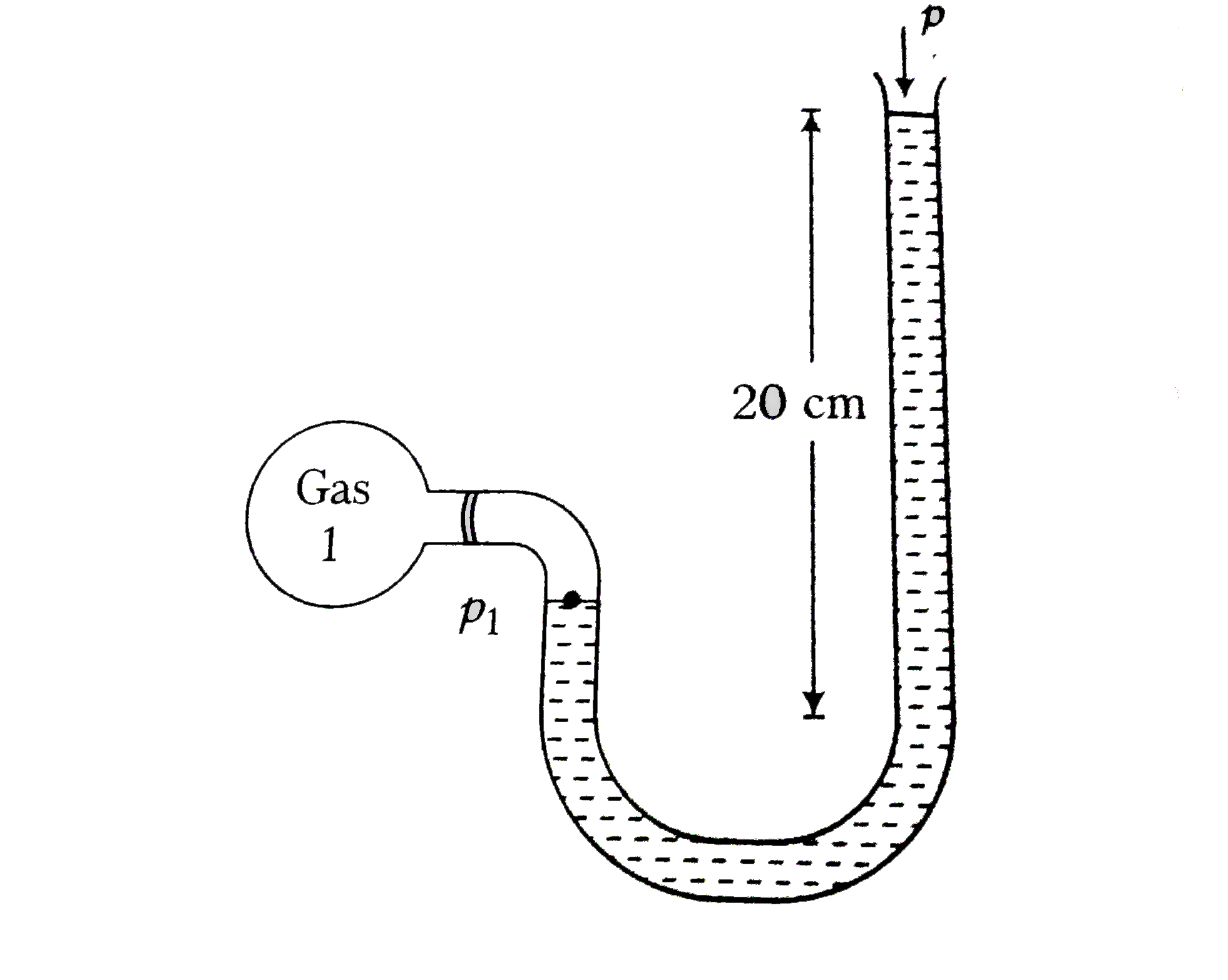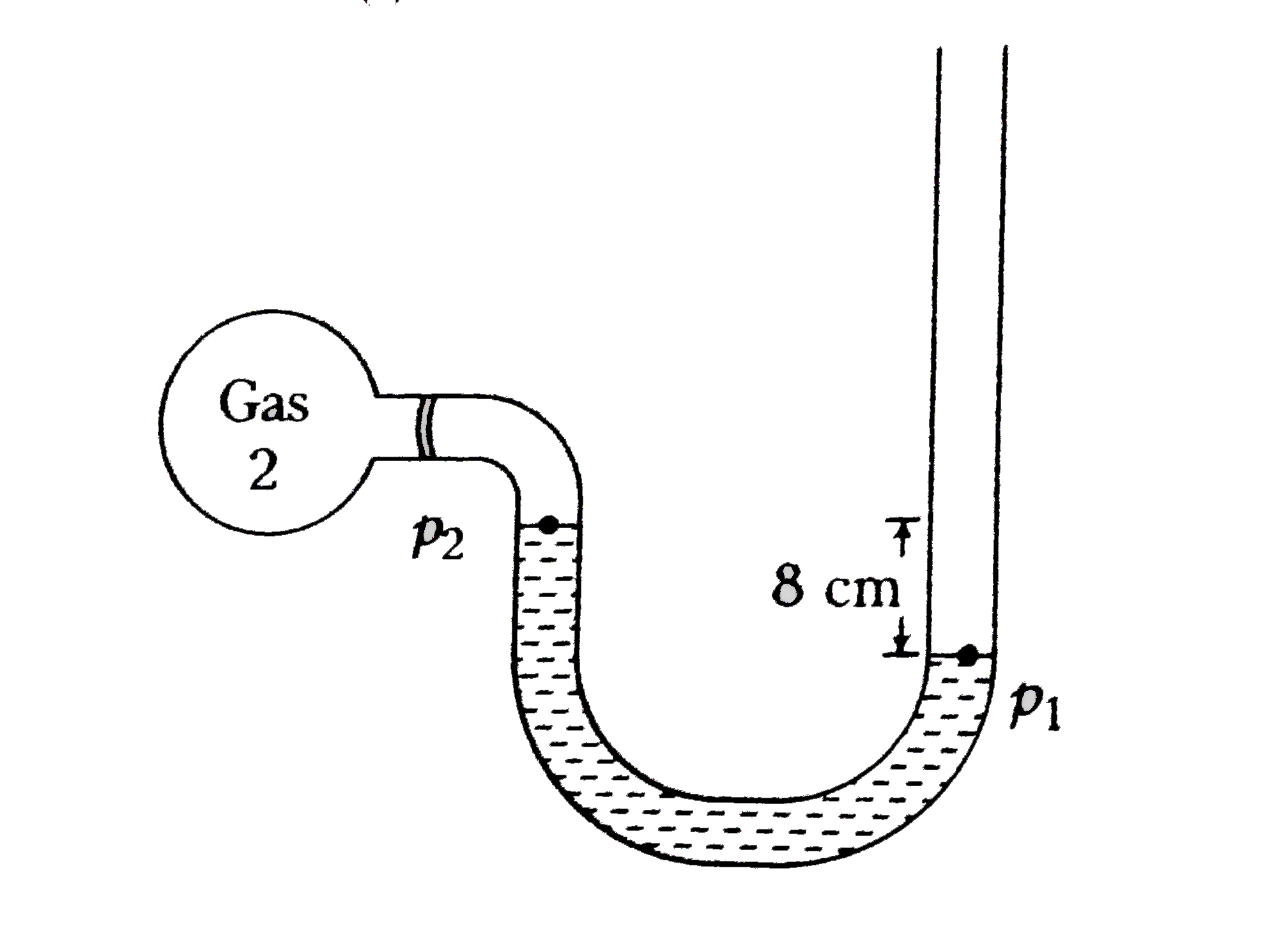A manometer tube contains a liquid of density . When connected to a vessel containing a gas, the liquid level in the other arm of the tube is higher by 20 cm. When connected to another sample of enclosed gas, the liquid level in the other arm of the manometer tube falls 8 cm below the liquid level in the first arm. Which of the two samples exerts more pressure and by what amount ?
Difference in level of liquids,
Pressure of the gas in the containing,

In this case, level of the liquid in the left arm is higher than that in the right arm by 8 cm.
Atmospheric pressure is greater than the pressure exerted by the sample
Comparing equations (i) and (ii), it is clear that .

Therefore the gas in sample 1 exerts greater pressure than that in sample 2.
The difference in the two pressures is
Topper's Solved these Questions
- FLUID MECHANICSBOOK - DC PANDEYCHAPTER - FLUID MECHANICSEXERCISE - Example 13.11
1 Videos
- FLUID MECHANICSBOOK - DC PANDEYCHAPTER - FLUID MECHANICSEXERCISE - Example 13.12
1 Videos
- FLUID MECHANICSBOOK - DC PANDEYCHAPTER - FLUID MECHANICSEXERCISE - Example 13.9
1 Videos
- EXPERIMENTSBOOK - DC PANDEYCHAPTER - EXPERIMENTSEXERCISE - Subjective
15 Videos
- GENERAL PHYSICSBOOK - DC PANDEYCHAPTER - GENERAL PHYSICSEXERCISE - INTEGER_TYPE
2 Videos
Similar Questions
A manometer tube contanins a liquid of density 3×103kgm−3. When connected to a vessel containing a gas, the liquid level in the other arm of the tube is higher by 10 cm. When connected to another sample of enclosed gas, the liquid level in the other arm of the manometer tube falls 7 cm below the liquid level in the first arm. Which of the two samples exerts more pressureand by what amount ?
View SolutionA manometer tube contains mercury of density 13.6×103 kg m−3. What difference in the levels of mercury in the two arms is indicated by a gauge pressure of 1.03×105Pa?
View Solution
Knowledge Check
A cube of ice is floating in a liquid of relative density 1.25 contained in a beaker . When the ice melts, the level of the liquid in the beaker ?
ARisesBFallsCRemain unchangedDFalls at first and then rises to the same height as beforeA manometer is connected to gas container. Then the mercury level rises by 2 cm in the arm of the manometer which is not connected to the container.
If the atmospheric pressure is 76 cm of mercury, then the pressure of the gas is ________ cm of mercury.A80B76C72D78A liquid X of density 3.36g/cm3 poured in a U-tube which contains Hg. Another liquid Y is poured in left arm with heght 8 cm upper levels of X and Y are same. What is density of Y?
A0.8g/cB1.2g/cC1.4g/cD1.6g/c
A manometer is connected to a gas containing bulb. The level of mercury in open arm is 2.6 cm lower than that in the other arm of the manometer. What is the pressure of the gas if the atmospheric pressure is 752 mm Hg?
View SolutionThe left arm of a manometer is connected to a container containing gas 'X' and the mercury level in the right arm is raised by 2 cm. Now without disconnecting the container of X, the right arm of the manometer is connected to another container containing gas 'Y' and the mercury level in the right arm is pushed down by 5 cm. Find the pressure exerted by the gases 'X' and 'Y'.
View SolutionWhen one limb of a manometer is connected to a container filled with a gas, the level of the mercury in the other limb rises by 'h' cm. Then the pressure of the gas in the container is 76+h cm of Hg.
View SolutionA gas is filled into a bulb connected to an open limb manometer. The level of mercury in the open arm is 2.1 cm lower than that in the other arm of the manometer. The atmospheric pressure is 740 mm. What is the pressure of the gas?
View SolutionA gas is filled into a bulb connected to an open limb manometer. The level of mercury in the open arm is 2.1 cm lower than that in the other arm of the manometer. The atmospheric pressure is 740 mm. What is the pressure of the gas?
View Solution
